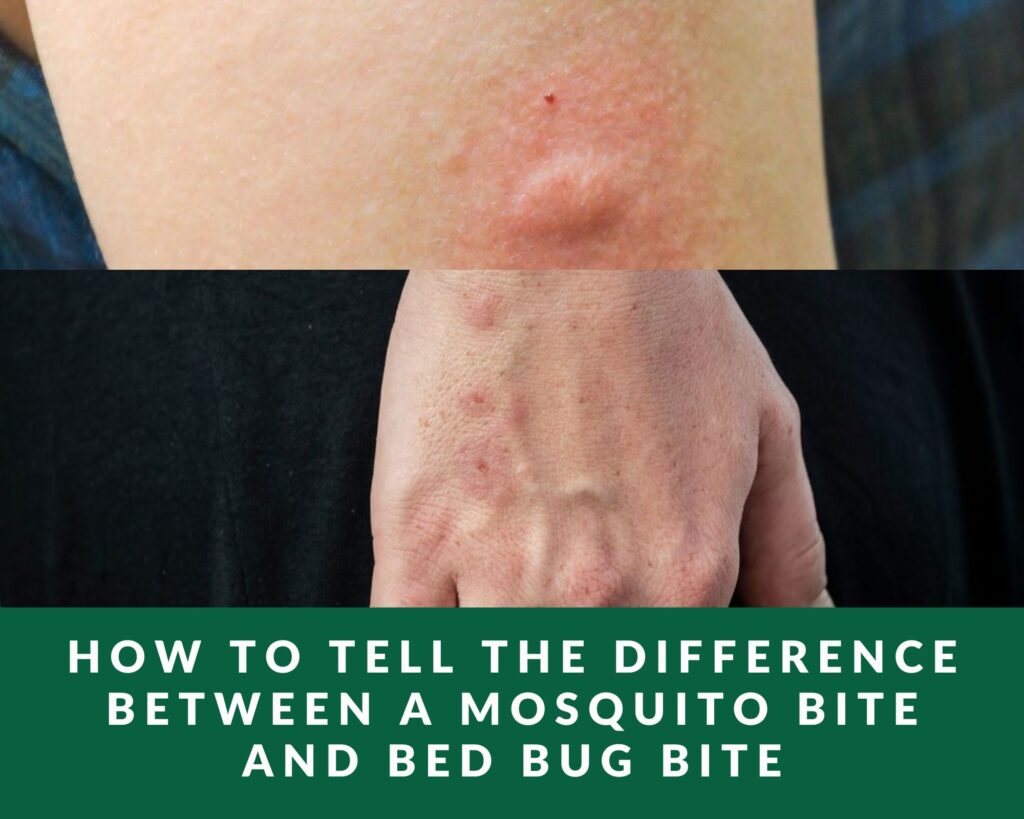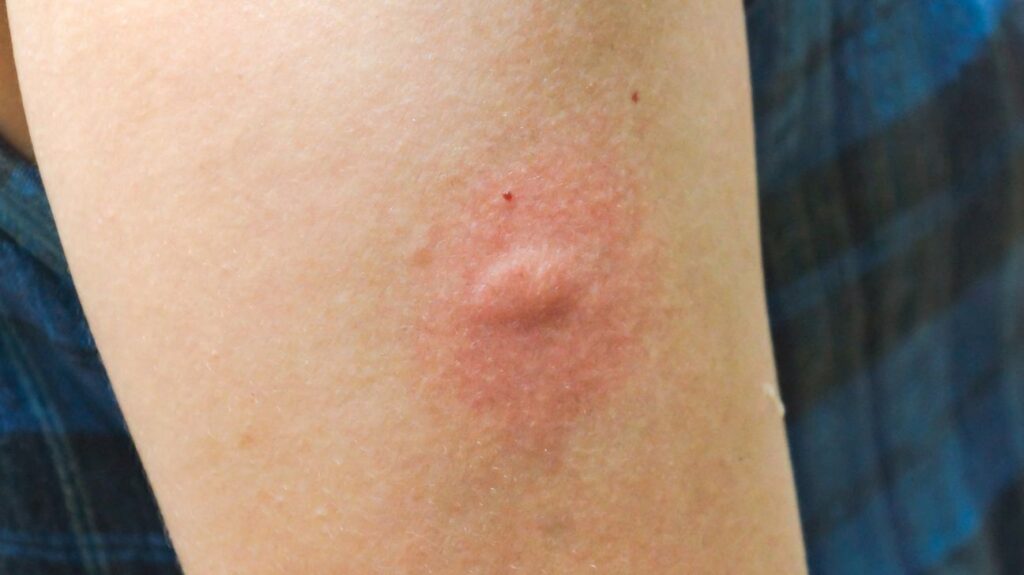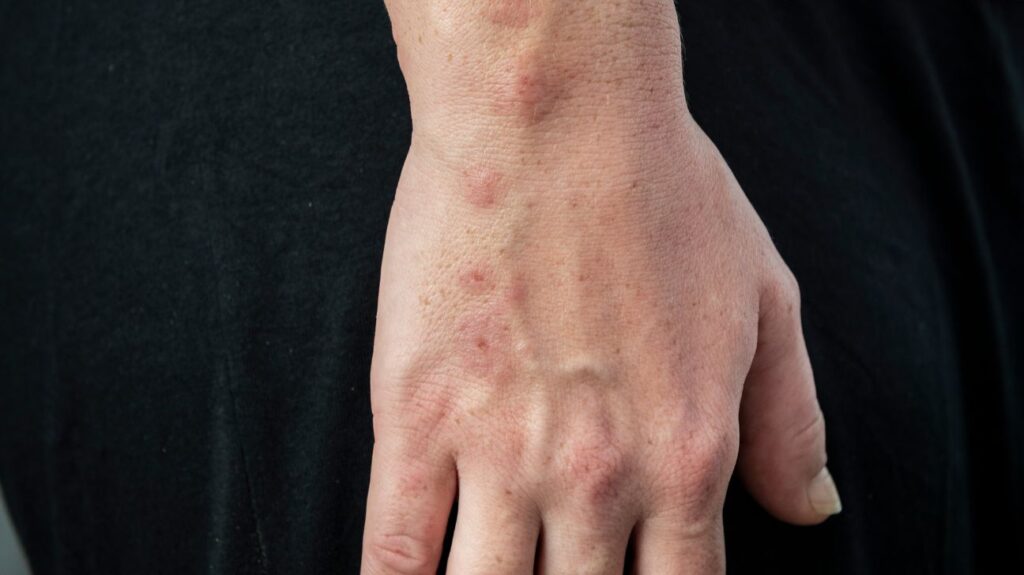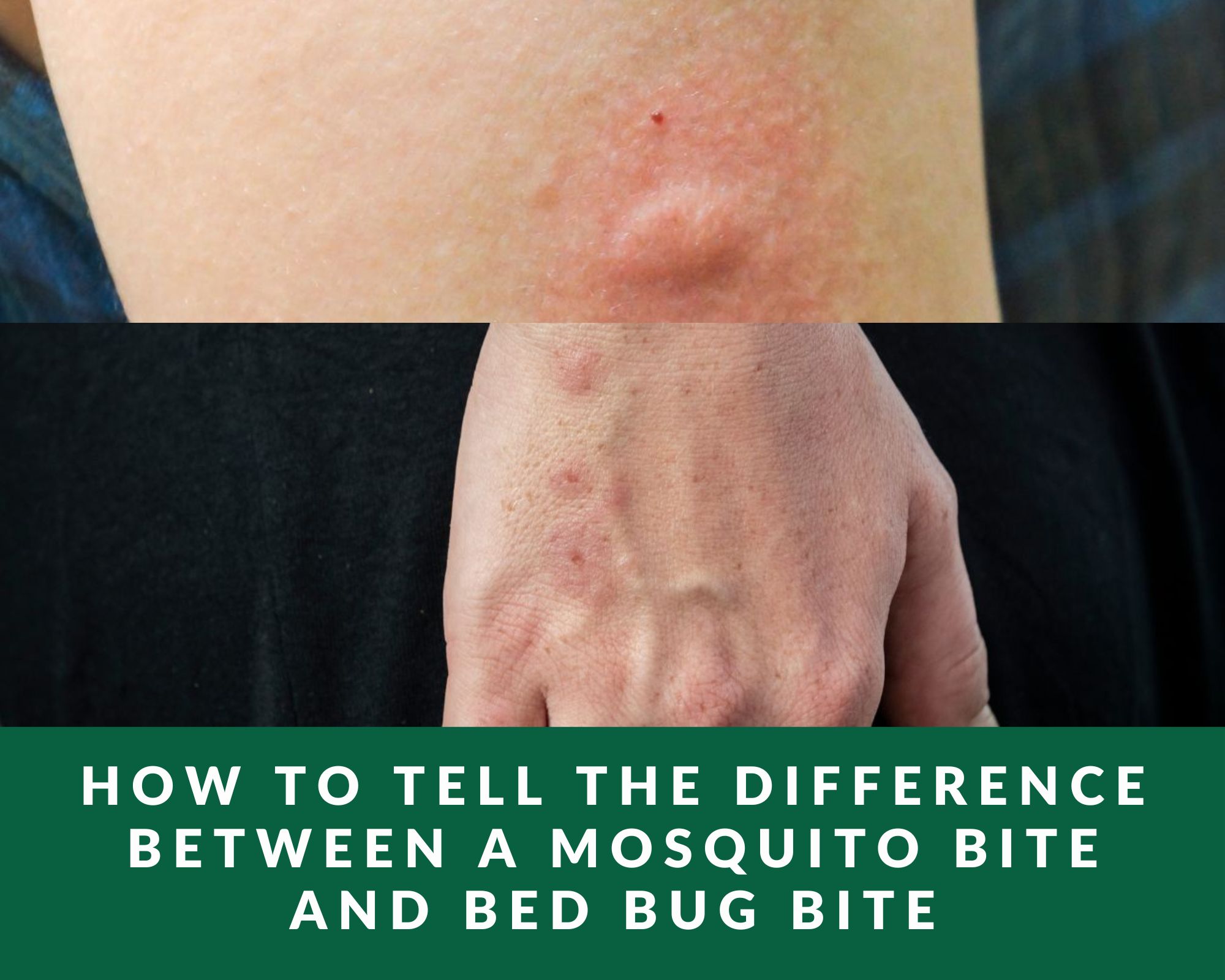How to tell the difference between a mosquito bite and bed bug bite:
Both bed bugs and mosquitoes like preying on both people and animals and they both need blood to survive. It can be difficult to distinguish between a mosquito bite and a bed bug bite at first appearance if you weren’t observable when it happened.
You can distinguish between the bites by carefully observing the symptoms and the way your bites look.

How to tell the difference between a mosquito bite and a bed bug bite
Pests like bed bugs and mosquitoes depend on human blood to survive. The heat and carbon dioxide that the human body produces also interests them both.
It can be difficult to visibly tell whether a bed bug or mosquito bit you considering the vast variety of reactions. You can still identify the offending insect by using some highlights in this article.
Here are some signs to watch out for so you can tell the difference between a mosquito bite and bed bug bite if you have been bitten.
Mosquito and bed bug bite symptoms
Bed bug bites and mosquito bites have many characteristics. The majority of individuals, however, struggle to tell the difference between bed bugs and mosquito bites because they both cause itchy skin rashes and exhibit comparable symptoms on human skin.
Read Also: How to Get Rid of Mosquito Bites Overnight
Bed bug bites symptoms
- Spots that are red and frequently have a darker area in the middle
- Itchy
- arranged roughly in a line or in a group
- noticeable on the face, neck, arms, and hands.
Mosquito bites symptoms
- An itchy, stinging, and red bump
- Emerging approximately 20 minutes after the insect bite
- A lump that becomes harder with time
- Bumps, blisters, or bruises filled with fluid
- The bite could enlarge over the course of two to three days before gradually getting better over the course of days or weeks. Some people may experience big reactions that range in size from 2 to 10 cm.
Bed bug bites vs mosquito bites
Bed bugs and mosquito bites differ in various aspects, including how they affect a person’s skin. How do you tell the difference between mosquito bites and bed bugs?
Read: How to Get Rid of Bed Bug Bites Overnight
Outward appearance
- Bites from bed bugs typically appear in groups and frequently follow a recognizable pattern, like a line or a zigzag. Bite wounds typically develop in places that a person exposes when sleeping.
- On the other hand, mosquito bites typically occur in isolated clusters and emerge at random on exposed skin.
Spread of disease
- Mosquitoes bite not only itch and irritate, but they also carry dangerous infections such as West Nile disease, Zika virus, and Malaria.
- In contrast to mosquitoes, researchers disagree that bed bugs transmit disease.
Time of reaction
- Most of the time, bed bug bites go unnoticed, and reactions only become apparent hours or days later. Symptoms usually go away without any further agitation within a week or more.
- On the other hand, a mosquito bite could be immediately itchy and noticeable. Usually, they recover in a day or two.
Do bed bug bites feel like mosquito bites
What mosquito bites look like

Mosquitoes are attracted to you for a number of reasons like the amount of carbon dioxide exhaled, body temperature. They utilize saliva as a medium to draw out as much blood from you as possible as rapidly as possible. The mouth portions of a mosquito are composed of many tubes.
One tube is used by the mosquito to suck up blood. Saliva is pumped into your blood vessels using a different tube.
Blood clotting is prevented by the saliva’s anticoagulant properties, which facilitate uninterrupted blood flow.
In response to saliva, the human body releases histamine, a chemical that widens blood vessels and speeds the delivery of white blood cells, blood plasma proteins, and other immune system components to the area of harm. However, during the process, histamine causes itchiness and irritation.
Bed bug bite picture

Before feeding on humans, bed bugs secrete a tiny quantity of anesthetic, which makes their bites virtually painless. Sometimes it takes a few days for bedbug bite symptoms to appear.
Bedbug bites may not cause any reaction in some people, but they may cause an adverse reaction in others, which may include intense itching, blisters, or hives.
Read Also: How many mosquito bites is dangerous
How to treat mosquito bite and bed bug bites
Bed bug and mosquito bites typically heal on their own within a week or two. To lessen itching caused by insect bites, we recommend the following:
Bed bug bite treatment
- Apply anti-itch lotion like calamine lotion. Calamine lotion can be used to treat bed bug bites and reduce itching. You should avoid applying alcohol or any other kind of treatment to the bites. After a few days, the redness and itching will go away.
- An oral antihistamine can also help to lessen itching and some individuals take Benadryl to help them fall asleep by reducing irritation and lulling them to sleep.
- Additionally, drink a lot of water to lessen inflammation and hasten the healing process. (Bed bugs are not known to transmit diseases like mosquitoes do.
How to treat bed bug bites on skin
Finding the bite is the first step. You can identify bed bug bites on skin by comparing the pattern of your bite marks to images online.
Once the bite has been located, it’s critical to refrain from scratching it in order to prevent the bug from spreading further. Scratching can spread the bed bug’s saliva, potentially resulting in more bites and discomfort.
One can apply a cold compress to the bite to reduce the itching and swelling that come along with it. This will lessen the inflammation and stop the itching from spreading. To relieve itching and discomfort from more severe bites, one can apply calamine lotion or hydrocortisone cream.
It is crucial to visit a doctor for additional medical guidance and a potential prescription for medication if the pain and itching continue.
Mosquito bite treatment
In a few days, the majority of mosquito bites cease itching and begin to heal. You could feel better at ease with these self-care suggestions.
- Using a paste, cream, or lotion to apply. Do not scratch an itch from a bite. Applying calamine lotion, an over-the-counter antihistamine, or a corticosteroid cream might be beneficial.
- Alternately, try soaking the bite with a paste composed of water and baking soda. Three times each day, administer the cream or paste to the area until the itching stops.
- Using an ice cube to rub. Rub an irritated bite for 30 seconds with an ice cube to try and relieve the itching.
- Applying pressure for five seconds is another method for relieving itchy bites.
How to make bug bites stop itching
There are several ways to relieve the itching caused by bug bites. Here are some options:
- Apply a cold compress: Wrap a few ice cubes in a clean cloth and hold it against the affected area for 10-15 minutes. The cold will help numb the nerves and reduce the itchiness.
- Use a topical cream: Over-the-counter creams containing hydrocortisone or calamine can help reduce itching and inflammation caused by bug bites. Apply the cream to the affected area as directed.
- Try natural remedies: Aloe vera gel, tea tree oil, and witch hazel are all-natural remedies that can help soothe bug bites. Apply a small amount to the affected area and see if it provides relief.
- Take an oral antihistamine: If the itching is severe or widespread, taking an oral antihistamine such as diphenhydramine (Benadryl) can help reduce the itchiness and other symptoms of an allergic reaction.
Bug bites similar to mosquito
Many different insect species can irritate human skin when they bite, in a manner similar to that of mosquito bites. Here are a few of the most typical bug bites like mosquito bites:
- Fleas: Flea bites typically appear as small, red, raised bumps that are often grouped together. They are commonly found around the ankles and legs.
- Bed bugs: Bed bug bites are usually red, itchy, and can be found in lines or clusters. They are often found on exposed skin, such as the arms, legs, and face.
- Chiggers: Chigger bites typically appear as red, itchy bumps that can be found around the waistband, ankles, and other areas where clothing fits tightly.
- Ticks: Tick bites can cause redness, swelling, and a circular rash. They are usually found in areas such as the armpits, groin, or scalp.
- Mites: Mite bites often appear as small, itchy red bumps that can be found in clusters on the skin. They are commonly found on the face, neck, and arms.
What other bug bites look like bed bug bites
There are several other bug bites that may resemble bed bug bites in appearance. Here are a few examples:
- Flea bites: Flea bites can look similar to bed bug bites, with raised, red bumps that may itch or burn. However, flea bites tend to be more spread out and can occur on any part of the body, whereas bed bug bites are usually found on exposed skin, such as the arms, legs, and face.
- Spider bites: Spider bites can also look similar to bed bug bites, with red, raised bumps that may be itchy or painful. However, spider bites can sometimes cause a more severe reaction, with symptoms such as fever, muscle cramps, and difficulty breathing.
- Mite bites: Mite bites can cause small, red bumps on the skin that may resemble bed bug bites. However, mite bites tend to be more spread out and can occur on any part of the body.
Final thoughts on the difference between a mosquito bite and bed bug bite
Remember to avoid scratching the affected area as this can make the itching worse and increase the risk of infection. If you experience any signs of an allergic reaction such as swelling or difficulty breathing, seek medical attention immediately.

